2016 MERCEDES-BENZ SL ROADSTER engine
[x] Cancel search: enginePage 147 of 333
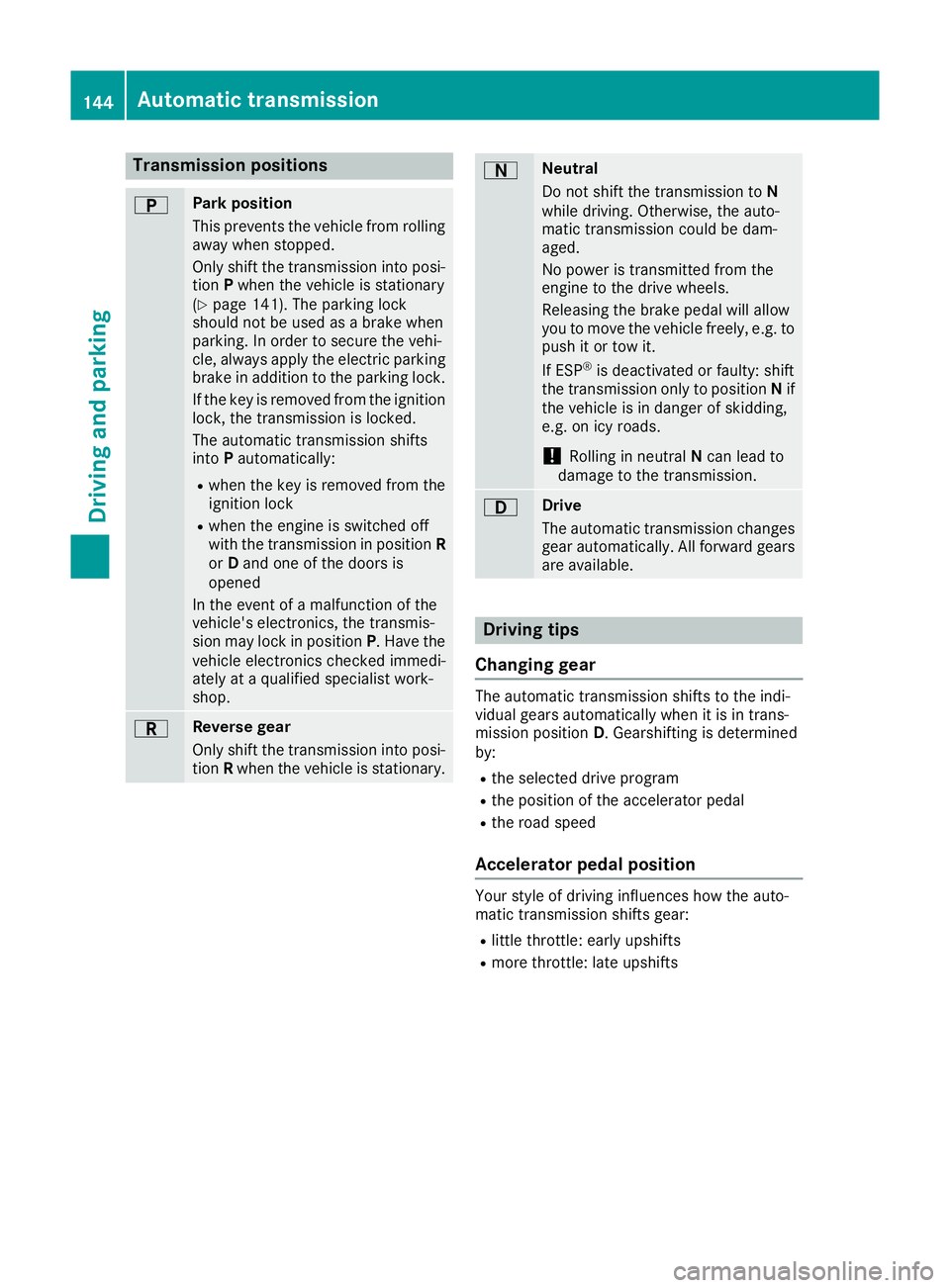
Transmission positions
B Park position
This prevents the vehicle from rolling away when stopped.
Only shift the transmission into posi-
tion Pwhen the vehicle is stationary
(Y page 141). The parking lock
should not be used as a brake when
parking. In order to secure the vehi-
cle, always apply the electric parking
brake in addition to the parking lock.
If the key is removed from the ignition lock, the transmission is locked.
The automatic transmission shifts
into Pautomatically:
R when the key is removed from the
ignition lock
R when the engine is switched off
with the transmission in position R
or Dand one of the doors is
opened
In the event of a malfunction of the
vehicle's electronics, the transmis-
sion may lock in position P. Have the
vehicle electronics checked immedi-
ately at a qualified specialist work-
shop. C Reverse gear
Only shift the transmission into posi- tion Rwhen the vehicle is stationary. A Neutral
Do not shift the transmission to
N
while driving. Otherwise, the auto-
matic transmission could be dam-
aged.
No power is transmitted from the
engine to the drive wheels.
Releasing the brake pedal will allow
you to move the vehicle freely, e.g. to push it or tow it.
If ESP ®
is deactivated or faulty: shift
the transmission only to position Nif
the vehicle is in danger of skidding,
e.g. on icy roads.
! Rolling in neutral
Ncan lead to
damage to the transmission. 7 Drive
The automatic transmission changes
gear automatically. All forward gears
are available. Driving tips
Changing gear The automatic transmission shifts to the indi-
vidual gears automatically when it is in trans-
mission position
D. Gearshifting is determined
by:
R the selected drive program
R the position of the accelerator pedal
R the road speed
Accelerator pedal position Your style of driving influences how the auto-
matic transmission shifts gear:
R little throttle: early upshifts
R more throttle: late upshifts 144
Automatic transmissionDriving an
d parking
Page 148 of 333

Kickdown
Use kickdown for maximum acceleration.
X Depress the accelerator pedal beyond the
pressure point.
The transmission shifts to a lower gear
depending on the engine speed.
X Ease off the accelerator pedal once the
desired speed is reached.
The automatic transmission shifts back up. Drive programs
All vehicles (except Mercedes-AMG
vehicles) Drive program C (Comfort)
Drive program Cis characterised by the follow-
ing:
R the vehicle pulls away more gently in forward
and reverse gears unless the accelerator
pedal is depressed fully.
R low fuel consumption resulting from the auto-
matic transmission shifting up sooner. The
vehicle is driven in the low engine speed range
and the wheels are less likely to spin.
R the suspension exhibits comfortable damping
settings.
R the steering exhibits a comfortable steering
curve.
R ESP ®
provides the optimum compromise
between traction and stability. Further infor-
mation on ESP ®
(Y page 67).
i Select this drive program for difficult road
conditions, e. g. snow and ice or wet road sur- faces.
Drive program S (Sport) Drive program Sis characterised by the follow-
ing:
R the vehicle exhibits sporty driving character-
istics.
R the vehicle pulls away in first gear.
R the automatic transmission shifts up later. As
a result of the later automatic transmission
shift points, the fuel consumption may be
higher.
R the suspension exhibits firm damping set-
tings. R
the steering exhibits a sporty steering curve.
R ESP ®
provides the optimum compromise
between traction and stability. Further infor-
mation on ESP ®
(Y page 67).
Drive program S+ (Sport Plus)
Drive program S+is characterised by the fol-
lowing:
R the vehicle exhibits particularly sporty driving
characteristics.
R the vehicle pulls away in first gear.
R the automatic transmission shifts up later. As
a result of the later automatic transmission
shift points, the fuel consumption may be
higher.
R the suspension exhibits particularly firm
damping settings (vehicles with adaptive
adjustable damping).
R the suspension exhibits firm damping set-
tings (vehicles with Active Body Control).
R the steering exhibits a sporty steering curve.
R ESP ®
emphasises the vehicle's own over-
steering and understeering characteristics.
This enables a more active driving style. This
drive program requires more interaction from
the driver. Further information on ESP ®
(Y page 67).
i Only select this drive program if the road
conditions are good, e.g. the road is dry and
the route ahead is clearly visible.
Drive program I (Individual)
In drive program Ithe following properties of the
drive program can be selected:
R the drive (engine and transmission manage-
ment)
R the suspension
R the steering
R the control thresholds of ESP ®
Information on configuring drive program Iwith
the multimedia system can be found in the Dig-
ital Owner's Manual. Automatic trans
mission
145Driving an d parking Z
Page 149 of 333
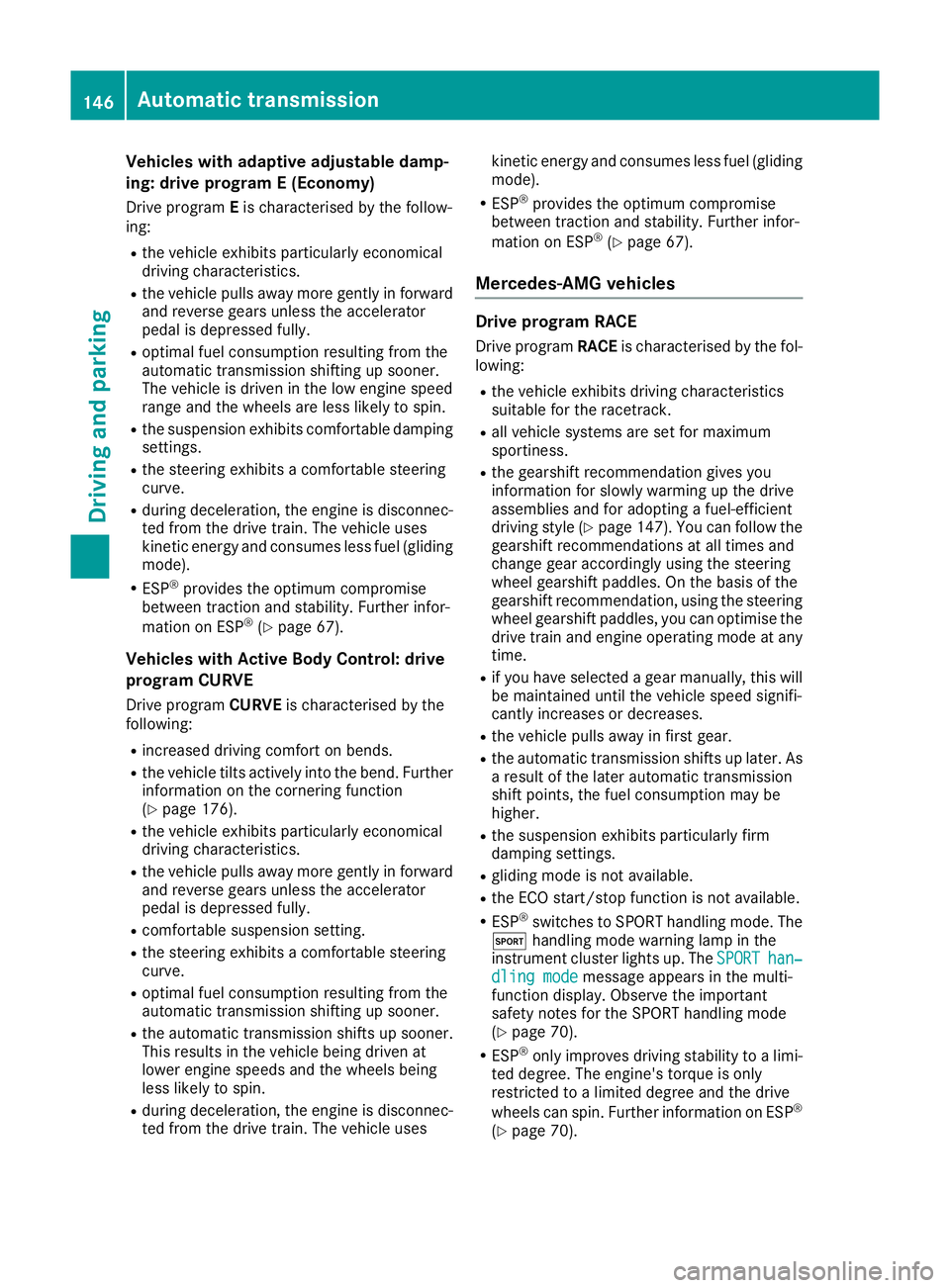
Vehicles with adaptive adjustable damp-
ing: drive program E (Economy)
Drive program Eis characterised by the follow-
ing:
R the vehicle exhibits particularly economical
driving characteristics.
R the vehicle pulls away more gently in forward
and reverse gears unless the accelerator
pedal is depressed fully.
R optimal fuel consumption resulting from the
automatic transmission shifting up sooner.
The vehicle is driven in the low engine speed
range and the wheels are less likely to spin.
R the suspension exhibits comfortable damping
settings.
R the steering exhibits a comfortable steering
curve.
R during deceleration, the engine is disconnec-
ted from the drive train. The vehicle uses
kinetic energy and consumes less fuel (gliding
mode).
R ESP ®
provides the optimum compromise
between traction and stability. Further infor-
mation on ESP ®
(Y page 67).
Vehicles with Active Body Control: drive
program CURVE
Drive program CURVEis characterised by the
following:
R increased driving comfort on bends.
R the vehicle tilts actively into the bend. Further
information on the cornering function
(Y page 176).
R the vehicle exhibits particularly economical
driving characteristics.
R the vehicle pulls away more gently in forward
and reverse gears unless the accelerator
pedal is depressed fully.
R comfortable suspension setting.
R the steering exhibits a comfortable steering
curve.
R optimal fuel consumption resulting from the
automatic transmission shifting up sooner.
R the automatic transmission shifts up sooner.
This results in the vehicle being driven at
lower engine speeds and the wheels being
less likely to spin.
R during deceleration, the engine is disconnec-
ted from the drive train. The vehicle uses kinetic energy and consumes less fuel (gliding
mode).
R ESP ®
provides the optimum compromise
between traction and stability. Further infor-
mation on ESP ®
(Y page 67).
Mercedes-AMG vehicles Drive program RACE
Drive program RACEis characterised by the fol-
lowing:
R the vehicle exhibits driving characteristics
suitable for the racetrack.
R all vehicle systems are set for maximum
sportiness.
R the gearshift recommendation gives you
information for slowly warming up the drive
assemblies and for adopting a fuel-efficient
driving style (Y page 147). You can follow the
gearshift recommendations at all times and
change gear accordingly using the steering
wheel gearshift paddles. On the basis of the
gearshift recommendation, using the steering
wheel gearshift paddles, you can optimise the drive train and engine operating mode at any
time.
R if you have selected a gear manually, this will
be maintained until the vehicle speed signifi-
cantly increases or decreases.
R the vehicle pulls away in first gear.
R the automatic transmission shifts up later. As
a result of the later automatic transmission
shift points, the fuel consumption may be
higher.
R the suspension exhibits particularly firm
damping settings.
R gliding mode is not available.
R the ECO start/stop function is not available.
R ESP ®
switches to SPORT handling mode. The
M handling mode warning lamp in the
instrument cluster lights up. The SPORT SPORThan‐
han‐
dling mode
dling mode message appears in the multi-
function display. Observe the important
safety notes for the SPORT handling mode
(Y page 70).
R ESP ®
only improves driving stability to a limi-
ted degree. The engine's torque is only
restricted to a limited degree and the drive
wheels can spin. Further information on ESP ®
(Y page 70). 146
Automatic transmissionDriving and parking
Page 150 of 333

Drive program S+ (Sport Plus)
Drive program S+is characterised by the fol-
lowing:
R the vehicle exhibits particularly sporty driving
characteristics.
R the vehicle pulls away in first gear.
R the automatic transmission shifts up later. As
a result of the later automatic transmission
shift points, the fuel consumption may be
higher.
R the suspension exhibits particularly firm
damping settings.
R gliding mode is not available.
R the ECO start/stop function is not available.
R ESP ®
provides the optimum compromise
between traction and stability. Further infor-
mation on ESP ®
(Y page 67).
Drive program S (Sport) Drive program Sis characterised by the follow-
ing:
R the vehicle exhibits sporty driving character-
istics.
R the vehicle pulls away in first gear.
R the automatic transmission shifts up later. As
a result of the later automatic transmission
shift points, the fuel consumption may be
higher.
R the suspension exhibits particularly firm
damping settings.
R gliding mode is not available.
R the ECO start/stop function is not available.
R ESP ®
provides the optimum compromise
between traction and stability. Further infor-
mation on ESP ®
(Y page 67).
Drive program C (Comfort) Drive program Cis characterised by the follow-
ing:
R the vehicle exhibits comfortable, economical
driving characteristics.
R the vehicle pulls away more gently in forward
and reverse gears unless the accelerator
pedal is depressed fully.
R the vehicle has improved driving stability, for
example on slippery road surfaces.
R optimal fuel consumption resulting from the
automatic transmission shifting up sooner.
The vehicle is driven in the low engine speed
range and the wheels are less likely to spin. R
gliding mode is available.
R the ECO start/stop function is available.
R ESP ®
provides the optimum compromise
between traction and stability. Further infor-
mation on ESP ®
(Y page 67).
Drive program I (Individual)
In drive program Ithe following properties of the
drive program can be selected:
R the drive (engine management)
R the transmission management
R ESP ®
R the suspension
Information on configuring drive program Iwith
the multimedia system can be found in the Dig-
ital Owner's Manual.
i To permanently shift the gears manually in
drive program Iusing the steering wheel pad-
dles, select the M(manual) setting for the
transmission. Manual gearshifting
General notes You can change gear yourself using the steering
wheel gearshift paddles. The transmission must
be in position D.
Depending on which gearshift paddle is pulled,
the automatic transmission immediately shifts
into the next gear up or down, if permitted.
To use manual shifting, you have two options:
R temporary setting
R permanent setting
If you activate manual gearshifting, the multi-
function display will show the current gear
instead of transmission position D.
If manual gearshifting is deactivated, the gears
will be selected automatically. Automatic transmission
147Driving and parking Z
Page 151 of 333
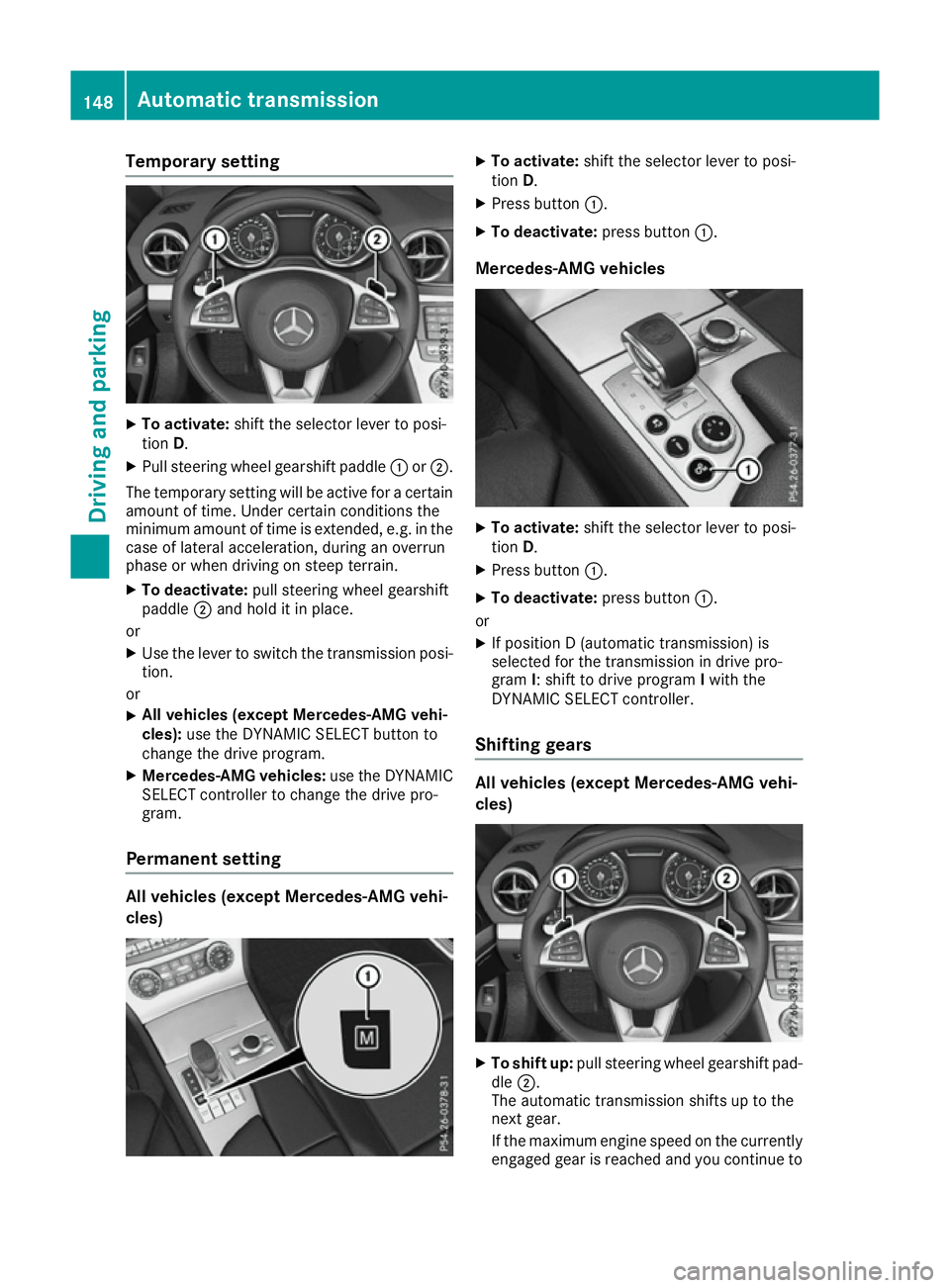
Temporary setting
X
To activate: shift the selector lever to posi-
tion D.
X Pull steering wheel gearshift paddle :or;.
The temporary setting will be active for a certain amount of time. Under certain conditions the
minimum amount of time is extended, e.g. in the
case of lateral acceleration, during an overrun
phase or when driving on steep terrain.
X To deactivate: pull steering wheel gearshift
paddle ;and hold it in place.
or X Use the lever to switch the transmission posi-
tion.
or X All vehicles (except Mercedes-AMG vehi-
cles):
use the DYNAMIC SELECT button to
change the drive program.
X Mercedes-AMG vehicles: use the DYNAMIC
SELECT controller to change the drive pro-
gram.
Permanent setting All vehicles (except Mercedes-AMG vehi-
cles) X
To activate: shift the selector lever to posi-
tion D.
X Press button :.
X To deactivate: press button:.
Mercedes-AMG vehicles X
To activate: shift the selector lever to posi-
tion D.
X Press button :.
X To deactivate: press button:.
or X If position D (automatic transmission) is
selected for the transmission in drive pro-
gram I: shift to drive program Iwith the
DYNAMIC SELECT controller.
Shifting gears All vehicles (except Mercedes-AMG vehi-
cles)
X
To shift up: pull steering wheel gearshift pad-
dle ;.
The automatic transmission shifts up to the
next gear.
If the maximum engine speed on the currently engaged gear is reached and you continue to 148
Automatic transmissionDriving an
d parking
Page 152 of 333
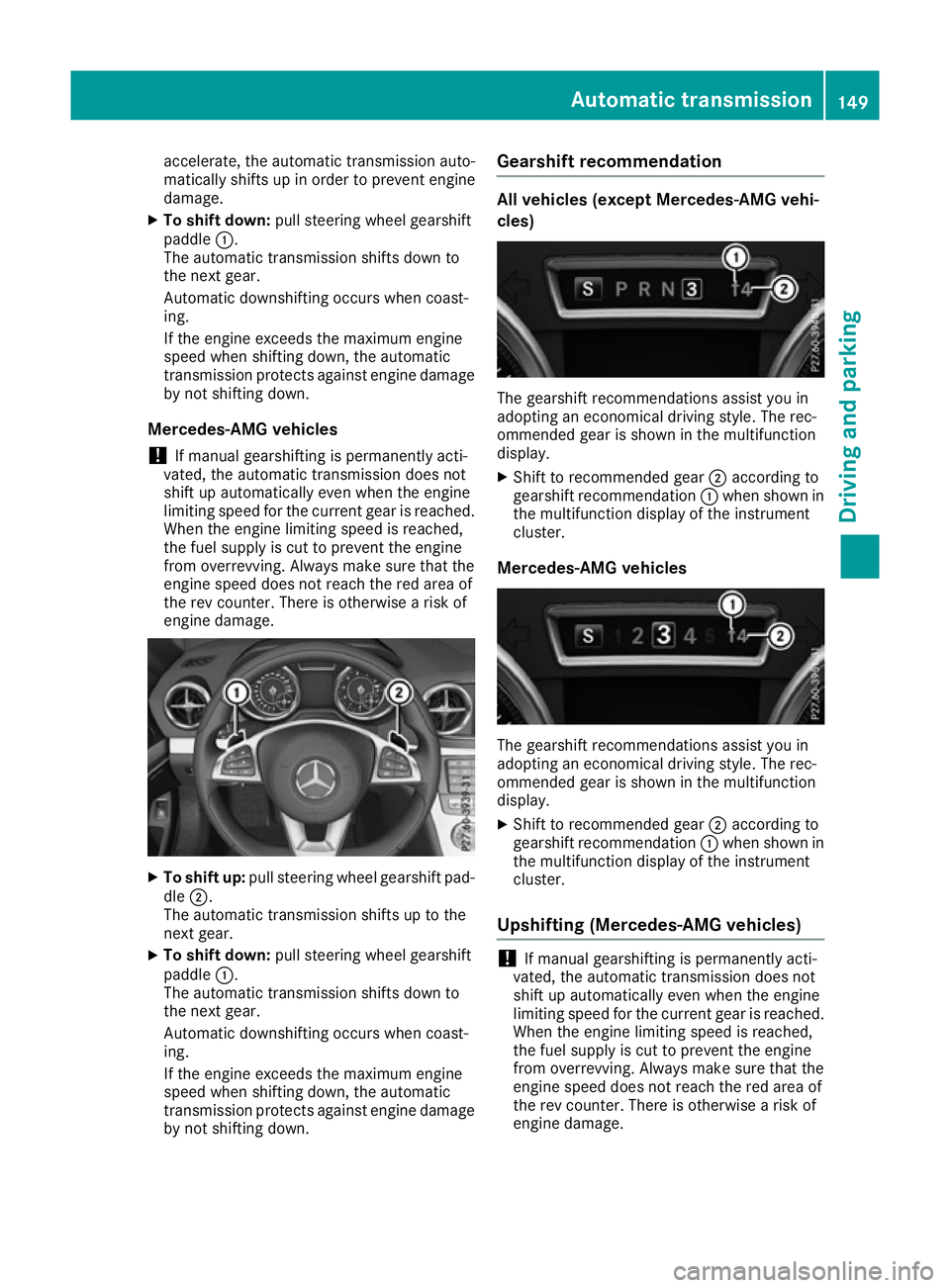
accelerate, the automatic transmission auto-
matically shifts up in order to prevent engine
damage.
X To shift down: pull steering wheel gearshift
paddle :.
The automatic transmission shifts down to
the next gear.
Automatic downshifting occurs when coast-
ing.
If the engine exceeds the maximum engine
speed when shifting down, the automatic
transmission protects against engine damage
by not shifting down.
Mercedes-AMG vehicles
! If manual gearshifting is permanently acti-
vated, the automatic transmission does not
shift up automatically even when the engine
limiting speed for the current gear is reached. When the engine limiting speed is reached,
the fuel supply is cut to prevent the engine
from overrevving. Always make sure that the
engine speed does not reach the red area of
the rev counter. There is otherwise a risk of
engine damage. X
To shift up: pull steering wheel gearshift pad-
dle ;.
The automatic transmission shifts up to the
next gear.
X To shift down: pull steering wheel gearshift
paddle :.
The automatic transmission shifts down to
the next gear.
Automatic downshifting occurs when coast-
ing.
If the engine exceeds the maximum engine
speed when shifting down, the automatic
transmission protects against engine damage by not shifting down. Gearshift recommendation All vehicles (except Mercedes-AMG vehi-
cles)
The gearshift recommendations assist you in
adopting an economical driving style. The rec-
ommended gear is shown in the multifunction
display.
X Shift to recommended gear ;according to
gearshift recommendation :when shown in
the multifunction display of the instrument
cluster.
Mercedes-AMG vehicles The gearshift recommendations assist you in
adopting an economical driving style. The rec-
ommended gear is shown in the multifunction
display.
X Shift to recommended gear ;according to
gearshift recommendation :when shown in
the multifunction display of the instrument
cluster.
Upshifting (Mercedes-AMG vehicles) !
If manual gearshifting is permanently acti-
vated, the automatic transmission does not
shift up automatically even when the engine
limiting speed for the current gear is reached. When the engine limiting speed is reached,
the fuel supply is cut to prevent the engine
from overrevving. Always make sure that the
engine speed does not reach the red area of
the rev counter. There is otherwise a risk of
engine damage. Automatic transmission
149Driving and parking Z
Page 153 of 333
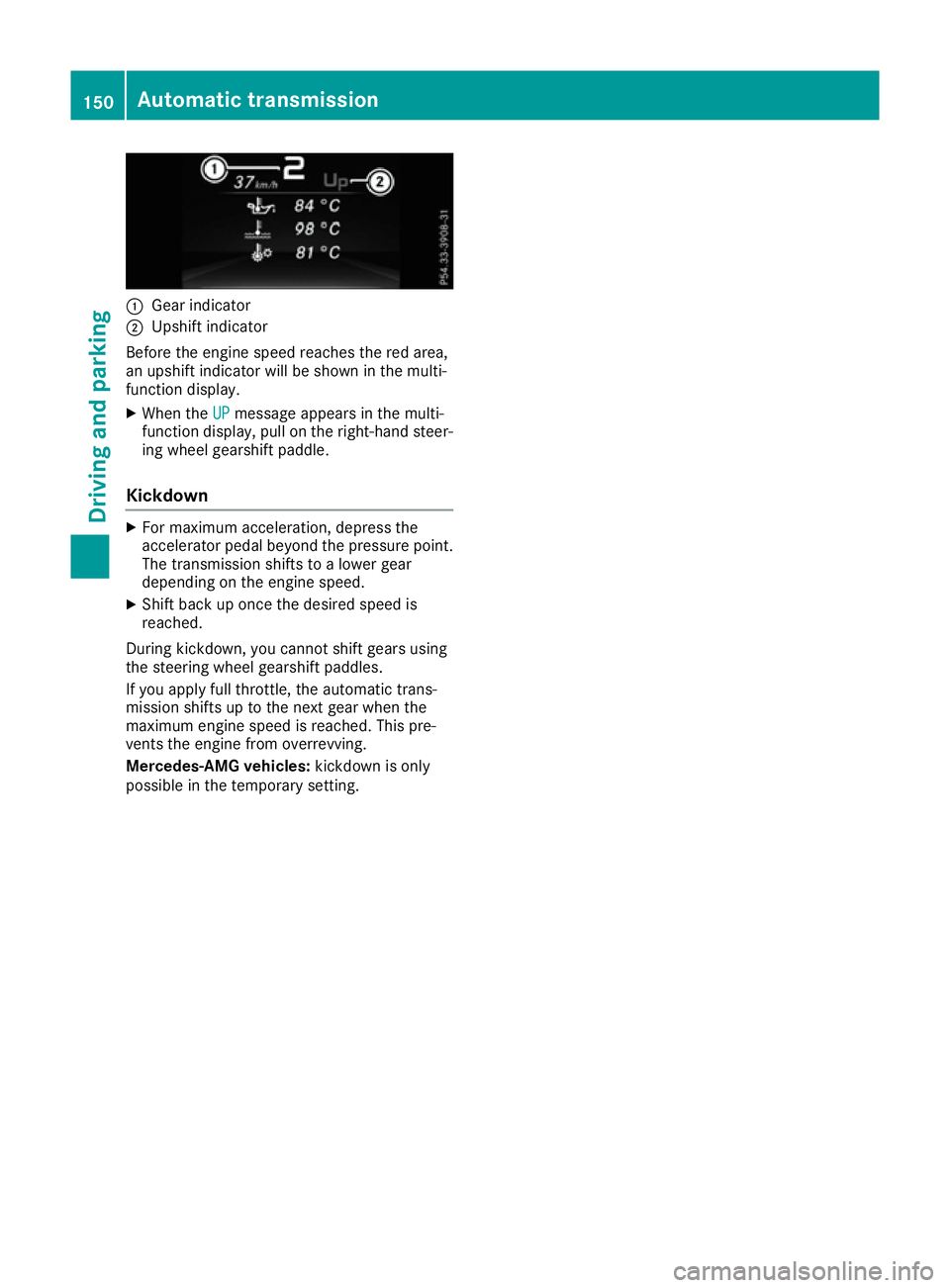
:
Gear indicator
; Upshift indicator
Before the engine speed reaches the red area,
an upshift indicator will be shown in the multi-
function display.
X When the UP
UPmessage appears in the multi-
function display, pull on the right-hand steer- ing wheel gearshift paddle.
Kickdown X
For maximum acceleration, depress the
accelerator pedal beyond the pressure point.
The transmission shifts to a lower gear
depending on the engine speed.
X Shift back up once the desired speed is
reached.
During kickdown, you cannot shift gears using
the steering wheel gearshift paddles.
If you apply full throttle, the automatic trans-
mission shifts up to the next gear when the
maximum engine speed is reached. This pre-
vents the engine from overrevving.
Mercedes-AMG vehicles: kickdown is only
possible in the temporary setting. 150
Automatic transmissionDriving and parking
Page 154 of 333

Problems with the transmission
Problem
Possible causes/consequences and
M
MSolutions The transmission has
problems shifting gear. The transmission is losing oil.
X Have the transmission checked at a qualified specialist workshop
immediately. The acceleration ability
is deteriorating.
The transmission no lon-
ger changes gear. The transmission is in emergency mode.
All vehicles (except Mercedes-AMG vehicles):
it is only partially
possible to engage the gears, or the transmission is in position N.
Mercedes-AMG vehicles: it is only possible to shift into secondgear
and reverse gear.
X Stop.
X Shift the transmission to position P.
X Switch off the engine.
X Wait at least ten seconds before restarting the engine.
X Shift the transmission to position Dor R.
Mercedes-AMG vehicles: ifD is selected, the transmission shifts
into second gear; ifRis selected, the transmission shifts into
reverse gear.
X Have the transmission checked at a qualified specialist workshop
immediately. Refuelling
Important safety notes
G
WARNING
Fuel is highly flammable. If you handle fuel
incorrectly, there is a risk of fire and explo-
sion.
You must avoid fire, naked flames, creating
sparks and smoking. Switch off the engine
and, if applicable, the auxiliary heating before refuelling. G
WARNING
Fuels are poisonous and hazardous to health. There is a danger of injury.
Do not swallow fuel or let it come into contact
with skin, eyes or clothing. Do not inhale fuel
vapours. Keep fuels out of the reach of chil-
dren. If you or others come into contact with fuel,
observe the following:
R Wash the fuel off any affected areas of skin
with water and soap immediately.
R If you get fuel in your eyes, rinse them thor-
oughly with clean water immediately. Seek
immediate medical attention.
R If fuel is swallowed, seek immediate medi-
cal attention. Do not induce vomiting.
R Change any clothing that has come into
contact with fuel immediately. G
WARNING
Electrostatic charge can cause sparks and
thereby ignite fuel vapours. There is a risk of
fire and explosion.
Always touch the vehicle body before opening the fuel filler flap or touching the fuel pump
nozzle. This discharges any electrostatic
charge that may have built up. Refuelling
151Driving and parking Z